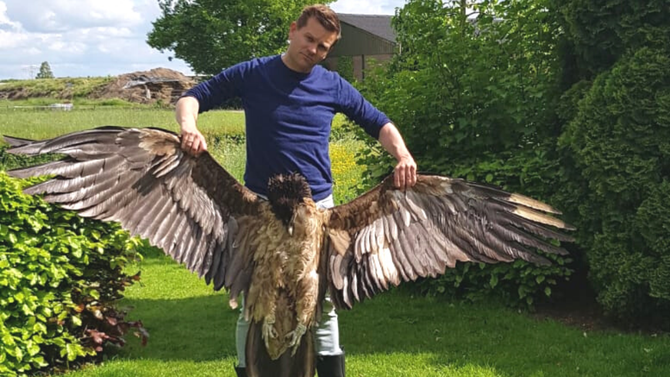| Wind Watch is a registered educational charity, founded in 2005. |
Please note that opinion pieces (including letters, editorials, and blogs), reflect the viewpoints of their authors; National Wind Watch does not necessarily agree with them in their entirety or endorse them in any way, nor should it be implied that the writers endorse National Wind Watch.
First in Europe: reintroduced Bearded Vulture that wandered in the Netherlands killed by wind farm
Credit: 26. May 2021 | Vulture Conservation Foundation | 4vultures.org ~~

It was bound to happen, and it did so this morning: the young Bearded Vulture Angèle that had been released last year in the Baronnies, as part of the LIFE GypConnect reintroduction project, and that had wandered to northern Europe, as many young Bearded Vultures do in their second year, has been found dead under a wind turbine in Wieringerwerf, the Netherlands, this morning.
Bearded Vulture dispersal and threat of wind farms
Bearded Vultures usually live in secluded mountain-top habitats, where wind farms are relatively rare or absent, but with their increasing population and range, instances of vagrancy have been increasing, and therefore the potential for accidents like this have also increased. Every year several Bearded Vultures, typically in their second or third year, leave their mountain ranges and usually fly north, sometimes to the lowlands of northern Europe. Several have reached northern France, the UK, Belgium, the Netherlands or even Denmark in the last few years.
This year already we had Eglazine spending some time in the plains of the Netherlands – this bird is currently in northern Germany, and recently Angèle followed its steps.
Multiple stakeholders significantly invested in breeding and eventually releasing Angèle in the wild as part of the efforts to reintroduce the Bearded Vulture in the Massif Central and Pre-Alps, with the ultimate goal to connect the population of the species between the Alps and the Pyrenees. Since his release nearly one year ago on 28 May 2020, Angèle spent the winter in the surrounding area, before dispersing further away in late spring, visiting the Massif Central, Paris, Dunkirk and flying out at sea north of Blankenberge in Belgium, before returning to land to Middelburg in the Netherlands.
Due to the poor weather during his stay in the Netherlands, Angèle flew through and roosted in some unusual places. He spent one of the nights in a small stand of trees next to a busy road, and eventually followed the coast and roosted for the night in Robbenoordbos, near a wind farm – in fact, yesterday afternoon it flew among the wind turbines, raising the alarm.
First Bearded Vulture fatality in Europe from wind turbine collision

The Vulture Conservation Foundation (VCF) has been closely following Angèle’s recent movements, notably Hans Pohlmann, the president of the management board, himself resident in the Netherlands, whom through local contacts kept an eye on the bird, even contacting one of the wind farms where the bird roosted last night. Unfortunately, while he was moving close to some other wind turbines this morning, Angèle met a tragic end when he collided with a blade at 09:27 and most likely died immediately.

To our knowledge, this is the first documented case of a Bearded Vulture killed by a wind turbine in Europe, but with the increasing populations, and also with the encroachment of wind farms in several places where Bearded Vultures now occur, such as the vital corridor between the Alps and the Pyrenees in southern France, this was bound to happen.
The VCF and partners have been engaging with a number of researchers and also with energy operators to provide data about the occurrence of this species, to try to prevent the establishment of wind farms in important corridors or breeding areas.
In place like the Netherlands, where the Bearded Vulture is a vagrant, it is important for operators to be open to some flexibility, and to develop shut down on demand processes that can in some situations avoid problems like this. This year alone two White-tailed Eagles have already died in wind farms in the country.
For more information, you can contact Hans Pohlmann, the VCF’s President, at h.pohlmann@4vultures.org or +31 6 27060735.
This article is the work of the source indicated. Any opinions expressed in it are not necessarily those of National Wind Watch.
The copyright of this article resides with the author or publisher indicated. As part of its noncommercial educational effort to present the environmental, social, scientific, and economic issues of large-scale wind power development to a global audience seeking such information, National Wind Watch endeavors to observe “fair use” as provided for in section 107 of U.S. Copyright Law and similar “fair dealing” provisions of the copyright laws of other nations. Send requests to excerpt, general inquiries, and comments via e-mail.
| Wind Watch relies entirely on User Contributions |
 (via Stripe) |
 (via Paypal) |
Share:
| Tag: Wildlife |

